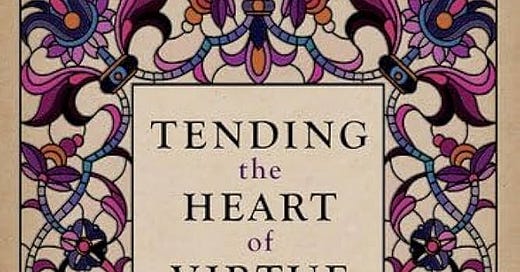As an Amazon Associate I earn from qualifying purchases
Guroian, Vigen. Tending the Heart of Virtue: How Classic Stories Awaken a Child’s Moral Imagination. Second Edition. Oxford University Press, 2023.
A conviction universally shared by classical educators is that the chief end of education is not merely the intellectual cultivation, but most fundamentally the moral formation of a person. We seek an education that touches and transforms the very soul of our students. To the question posed by Socrates to Meno ("Can virtue be taught?") an implicit affirmation is given by all in the classical community. Yet the follow up question ("How can be virtue be taught?") inspires a much greater diversity of responses. While much has been written about the formation of character both inside and outside of the classroom, I can think of few texts that address this question as sublimely as Tending the Heart of Virtue: How Classic Stories Awaken a Child's Imagination by Vigen Guroian. Now in its second edition, Vigen Guroian expands upon the influential work he penned over twenty-five years ago.
His first line, "Children are vitally concerned with distinguishing good from evil, and truth from falsehood," lays the foundation. This desire must be nurtured and kindled. As advocates of classical education well know, this natural inclination is far too often snuffed out in today's world. This most obviously occurs when adults who do not believe that neither good and evil nor truth and falsehood are distinguishable impose their outlook upon the next generation. However, young people’s natural concern for virtue more often diminishes when they are not properly nurtured, when adults neglect to feed them the oxygen that fuels their fire. One necessary component that undergirds this propensity in children is the "moral imagination."
In his first two chapters, Guroian develops his underlying argument. He deftly interweaves the insights of great thinkers into these chapters, demonstrating to us that:
"Mere instruction in morality is not sufficient to nurture the virtues. It might even backfire, especially when the presentation is heavily exhortative and the pupil feels coerced. Instead a compelling vision of the goodness of goodness itself needs to be presented in such a way that it is attractive and stirs the imagination."
This is true, not only because of that natural tendency in us to resist compulsory instruction, but because moral theories and abstract arguments are neither fully accessible nor ultimately compelling to the young mind. While a demonstration of these may be important to developing our character, and necessary at some point, Guroian argues that it is not sufficient. Stories are uniquely suited to fulfill this need. And fairy tales hold a special category of their own.
"The great fairy tales and fantasy stories communicate the meaning of morality through vivid depictions of the struggle between good and evil, where characters must make difficult choices between right and wrong, or heroes and villains contest the very fate of imaginary worlds.”
Stories such as these are universal. Their imagery and metaphors transcend time and geography, reaching something primordial in all of us. As children take in story after story of good overcoming evil, it supplies them with a rich wealth of experience they would otherwise never have. Children learn of courage and friendship and cowardice and betrayal not as working definitions, but as they see their beloved characters making courageous or cowardly choices. These images, metaphors, and narratives become the building blocks that develop their understanding of good and evil. It is comprehended both cognitively and emotionally.
The remaining chapters, and the bulk of the text, fulfills Guroian's principal objective "to be a helpful guide through some of the most beloved fairy tales and classic and contemporary stories written for children." His deep love for these classic tales colors them with a depth and dignity so often lost in the translation of these stories the modern media. He illuminates for us the meaning and universality of these stories in such a way that one feels they have encountered them for the first time. He is careful to model for us how to avoid reductionism of these tales to mere platitudes. His deep respect for the dignity of each child pervades this text. Children deserve direct access to the whole of humanity: heroes and the villains in all of their forms. We are shown how to encounter this world ourselves and how to guide our children through this world. A world where good and evil are clearly distinguishable yet embodied in all the complexities of living flesh (and fur). Seven chapters, with titles such as “Love and Immortality in The Velveteen Rabbit and “The Little Mermaid” inspire the reader to pick up each of these classic tales and read them ourselves.
This book reignited my love of fairytales and reached the child in me that yearns for the knight to defeat the dragon and the wicked stepmother to fall into her own trap. It helped me reassess the “utility” of imaginative literature, seeing it to be just as necessary as direct moral instruction. In the end, I hope you too are compelled by this simple conclusion: adults and children alike should not only read fairy tales, but every one of us needs fairy tales.
Stephen Philabaum has spent over thirteen years serving in classical schools, ten of which have been in school leadership. He served at Great Hearts Academies teaching and leading in both upper and lower schools across the Phoenix metropolitan area, last serving as the Founding Headmaster of the elementary at Great Hearts Roosevelt. He recently joined the classical network American Classical Schools of Idaho and is now the Upper School Principal at Treasure Valley Classical Academy. He is passionate about the moral formation of children and is currently pursuing a M.A. in Character of Education at the University of Birmingham. He lives in the Boise metropolitan area with his wife Reina, and three children, Adam, Ezra, and Sophia, all of whom love reading great stories together.




